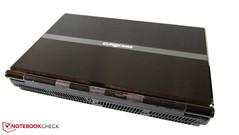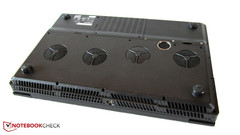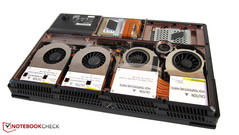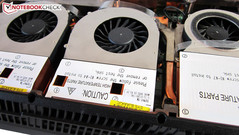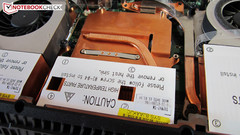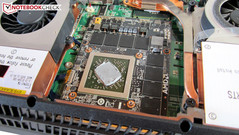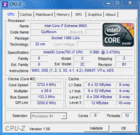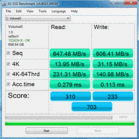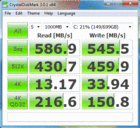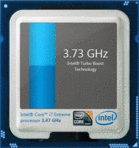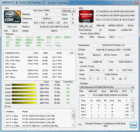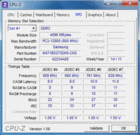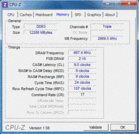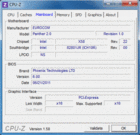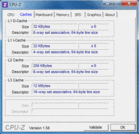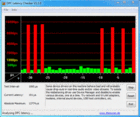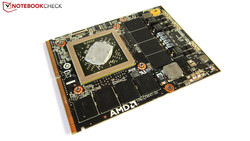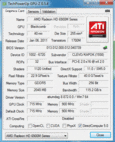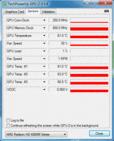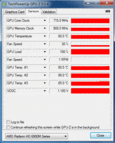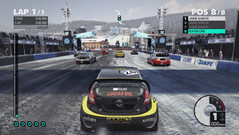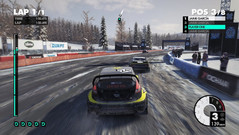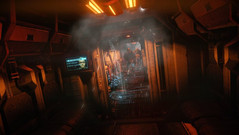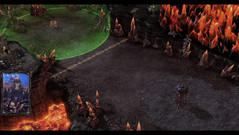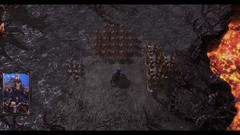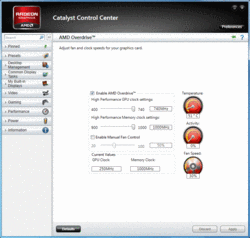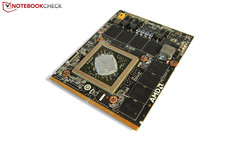Review AMD Radeon HD 6990M Graphics Card

Demanding gamers, who consider PC towers as outdated relics, find that gaming laptops make adequate replacements. In the past few years, the power of mobile graphic cards has jumped through the roof, and today these tiny chips can even run the most demanding games with maximum details and all the extra features on (Anti-Aliasing and Anisotropic Filtering).
AMD and Nvidia (two of the biggest GPU manufacturers) are constantly at each other's throats for the title of best graphics card. Nvidia has held first place for a while thanks to the GeForce GTX 485M and its successor, the GeForce GTX 580M, but now AMD has countered with the Radeon HD 6990M (which relieves the Radeon HD 6970M from the top spot of the AMD mobile graphics card line-up). Although AMD does not offer a multitude of features like its Nvidia counterpart, the Radeon HD 6990M remains a big threat, as it is a high-end model which is priced far lower than its Nvidia competition (GeForce GTX 485M and GTX 580M cost a few hundred Euros more than the HD 6990M). Let us take a quick peek at the test system, before we move on to the benchmarks.
Test System
The Canadian manufacturer Eurocom has provided us with one of its strongest platforms for the Radeon HD 6990M test. The 17 inch Panther 3.0 is based on the massive and 6 kg heavy Clevo X7200 barebone (see, for example, Schenker Xirios W710). The case is big enough to accommodate two AMD or Nvidia GPUs at the same time.
In contrast to most notebooks, the processor of this model is a server/desktop CPU (max. 135 W TDP). Our test model contained one of the most expensive and strongest processors available on the market: the Core i7-990X. The six cores can run at speeds ranging between 3.46 and 3.73 GHz (Turbo-Boost function) depending on the temperature and load. Thanks to the Hyperthreading technology (each real core can generate a virtual core), the CPU can process up to 12 threads simultaneously.
The Eurocom Panther 3.0 is extremely well-equipped with other high-end hardware modules, such as: 12 GB DDR3-RAM (1600 MHz @ 1333 MHz) and three Intel 510 SSDs in RAID 0 (each 250 GB). The performance of the three Solid State Drives in RAID mode is incredible. We measured a sequential read and write rate of 600 MB/sec with the AS SSD benchmark. So how much does all this cost? Eurocom has priced this configuration above 5000 Euros - hefty.
The graphic card can be easily accessed, as can be seen from the photos. To free the graphic card, we had to first remove the fan and the heatsink (total of 8 screws). The smaller and less famous barebones, such as the P150HM (for example, Schenker XMG P501 PRO) and the P170HM (for exapmle, DevilTech Fragbook DTX) have the same design for the graphic card slot.
Test configuration:
- Windows 7 Home Professional 64 Bit
- Intel X58 Chipset
- Intel Core i7-990X EE (Desktop-Hexa-Core)
- AMD Radeon HD 6990M (2048 MB GDDR5-VRAM)
- 17.3“ Full-HD LED Display (Glare)
- 12 GB DDR3-RAM (1600 MHz @ 1333 MHz)
- 3x Intel 510 SSD in RAID0 (SSDSC2MH250A2, each 250 GB)
- Starting price: 2189 Euros (Device price ranges depending on the configuration)
Links:
- News: Radeon HD 6990M announced
- Review: GeForce GTX 580M
- Review: GeForce GTX 485M
- Review: Radeon HD 6970M
Technology
Enough about the case - time to take a look at the graphic card itself. The Radeon HD 6990M resembles its predecessor (the HD 6970M) in a few ways. Both graphic cards use the desktop Barts chip with 1700 million transistors and have 2 GB of fast GDDR5 VRAM which operates at 900 MHz (bandwidth: 115.2 GB/s). The memory interface is also identical; 256 bit is right now more than enough for GDDR5 memory. The GPUs were produced in the 40 nm format.
The clock frequency of the core has been increased from 680 MHz to 715 MHz (+5%). The biggest difference is the number of shaders: AMD has increased the number of stream processors from 960 to 1120 (+17%). The pixel fill rate has risen 5% (22.9 vs. 21.8 GPixel/s), and the texture fill rate has increased about 23% (40.0 vs. 32.6 GTexel/s).
Thanks to the "Overdrive" menu (see screenshot), overclocking the card is very easy. While idle the Radeon HD 6990M ran at a relatively high 250 MHz (core) and 900 MHz (memory), and under full load (Furmark & Prime), the normal 715/900 MHz was held constant.
Features
The following is a list of the features offered by the Radeon HD 6990M:
◊ DirectX 11: Gamers will be happy to know that the graphic card delivers DX 11 support. Using Tessellation, surfaces can be delineated with extraordinary depth and detail (as can be seen from the Unigine Heaven benchmark).
◊ HD3D Technology: The support for the playback of stereoscopic 3D material is also available. So, users who have the other hardware and accessories necessary, such as an appropriate monitor, 3D glasses, etc. can enjoy games, photos, and (Blu-ray) in the third dimension. Hint: Nvidia's 3D Vision is much more refined.
◊ CrossFire: This feature is for enthusiasts who love performance. Two graphic cards can be used together in a so-called "CrossFire" mode (short CF). However, two GPUs make the price, power usage and cooling requirement double, and, last but not least, the dual-GPU configuration will be heavily dependent on drivers.
◊ UVD3 Video-Decoder: the integrated UVD3 decoder decodes video files on the graphic card, which saves the processor a lot of work. The supported formats include: Adobe Flash, MVC, MPEG-2, MPEG-4 AVC/H.264, MPEG-4 Part 2 (DivX, Xvid) und VC-1.
◊ HD Audio-Controller: Users, who have an external monitor with an HDMI interface and a "Surround-Sound" system, will want an easy way to transfer the 7.1-Sound from the PC to the speaker. The Radeon HD 6990M is capable of achieving this and supports formats, such as, AC-3, AAC, Dolby TrueHD and DTS-HD Master Audio.
◊ Eyefinity: This feature allows users to connect up to 6 monitors to their AMD card, and use them all simultaneously. Sadly, due to the lack of interfaces (DisplayPorts), most notebooks can only support two monitors.
Benchmarks
The synthetic benchmarks focused on the DX 11 performance. The results of the DX 9 and 10 benchmarks can be seen at Radeon HD 6990M and in our in-depth comparison list. Our test model has the latest 11.8 Catalyst graphics driver (version 8.872).
3DMark 11
The Radeon HD 6990M delivers a great performance in the 3DMark 11 (1280 x 720, Performance setting). The GPU score of 3179 points beats almost all single mobile graphic cards. The Radeon HD 6970M is left behind at 2834 points @ Eurocom Racer (-11%), The GeForce GTX 485M scores around 16% less (2668 points @ Schenker XMG P501). The GeForce GTX 580M rubs shoulders with its AMD competition with a score of 3191 points (Alienware M17x R3). In our experience, the 3DMark 11 benchmark usually favors the AMD graphic cards.
| 3DMark 11 - 1280x720 Performance GPU (sort by value) | |
| Eurocom Panther 3.0 | |
| Eurocom Racer | |
| Alienware M17x R3 GTX 580M i7-2820QM | |
| Schenker XMG P501 | |
Unigine Heaven 2.1
The Unigine Heaven benchmark (1280 x 1024, High, Tessellation normal) favors Nvidia. The Radeon HD 6990M (37.2 fps) can not beat the GeForce GTX 485M (40.9 fps, +10%), or the GeForce GTX 580M (43.8 fps, +18%). The cheaper Radeon HD 6970M lies further behind: 33.2 fps (11% gap). However, the performance of all four graphic cards is very strong, and so the user should be content for the next 1-2 years.
| Unigine Heaven 2.1 - 1280x1024 high, Tesselation (normal), DirectX11 AA:off AF:1x (sort by value) | |
| Eurocom Panther 3.0 | |
| Eurocom Racer | |
| Alienware M17x R3 GTX 580M i7-2820QM | |
| Schenker XMG P501 | |
Gaming Performance
Let us move on to the gaming performance. For our game tests, the Eurocom Panther 3.0 had to compete with the Eurocom Racer (Core i7-2720QM, Radeon HD 6970M), as well as the Schenker XMG P501 (Core i7-2720QM, GeForce GTX 580M). In an attempt to hold the influence of the CPU to a minimum, we picked the highest settings with a resolution of 1920 x 1080 pixels. The use of any other model, aside from the ones mentioned above, is noted in the game test.
Dirt 3
Almost every years, Codemasters releases a high-quality racing game. Their latest creation, Dirt 3, is delivered smoothly to the screen with ultra high details by the Radeon HD 6990M. The graphic card managed 35.3 fps in the integrated game benchmark with 4x AA and a resolution of 1920 x 1080 pixels.
Most notebooks cannot run Dirt 3 with maximum details (the GeForce GTX 560M runs the game at a meager 23 fps). On the other hand, the GeForce GTX 580M sprints ahead of the Radeon HD 6990M with 44.2 fps - an increase of about 25%.
| Dirt 3 | |||
| Resolution | Settings | Value | |
| 1920x1080 | Ultra Preset, 4xAA, -AF | 35.3 fps | |
| 1360x768 | High Preset, 2xAA, -AF | 75.6 fps | |
| 1024x768 | Medium Preset, 0xAA, -AF | 96.1 fps | |
| 800x600 | Ultra Low Preset, 0xAA, -AF | 209.5 fps | |
Crysis 2
The demanding Ego-Shooter, Crysis 2, takes everything the Radeon HD 6990M has to offer and is hungry for more. Even without the DirectX 11 patch, and high-resolution textures, the single player campaign did not run fluidly. Fraps measured on average 34 fps with 1920x1080 pixels and Extreme settings. Sadly, that is too little for a game which runs in the First-Person perspective.
Nvidia's GeForce GTX 580M cannot distance itself in this case. It delivers practically the same result with 34.1 fps. The Radeon HD 6970M (Schenker XMG U700 ULTRA) has to deal with 30.2 fps (-11%).
| Crysis 2 | |||
| Resolution | Settings | Value | |
| 1920x1080 | Ultra DX11 High Res Textures | 25.2 fps | |
| 1920x1080 | Extreme | 34 fps | |
| 1366x768 | Very High | 103 fps | |
| 1024x768 | High | 134.3 fps | |
| 800x600 | High | 186.4 fps | |
Call of Duty: Black Ops
The benchmark results from Call of Duty: Black Ops surprised us. As in, Modern Warfare 2 and Starcraft 2, the performance of the Radeon HD 6990M lay lower than that of the slower Radeon HD 6970M. While the latter managed 74.5 fps (1920 x 1080, Extra, 4x AA & 8x AF) in single player campaign, the HD 6990M could "only" deliver 70.1 fps (-6%).
We do not know if this lower performance is due to the "Engineering" status of our test model or the still not (yet) perfectly optimized GPU driver. The GeForce GTX 580M is naturally overjoyed by this weakness and jumps far ahead of the Radeon HD 6990M (87.3 fps - +25%).
| Call of Duty: Black Ops | |||
| Resolution | Settings | Value | |
| 1920x1080 | extra, 4xAA, 8xAF | 70.1 fps | |
| 1360x768 | high, 2xAA, 4xAF | 86.4 fps | |
| 1024x768 | medium, 0xAA, 0xAF | 91.9 fps | |
| 800x600 | low (all off), 0xAA, 0xAF | 131.4 fps | |
Mafia 2
The Radeon HD 6970M can also fluidly display the game, but its fps is 7% lower on average (55.9 fps). Nvidia's GeForce GTX 580M takes the lead once again with 65.6 fps which is a plus of 9%.
| Mafia 2 | |||
| Resolution | Settings | Value | |
| 1920x1080 | high, 0xAA, 16xAF | 60.3 fps | |
| 1360x768 | high, 0xAA, 16xAF | 85.1 fps | |
| 1024x768 | medium, 0xAA, 8xAF | 93.1 fps | |
| 800x600 | low, 0xAA, 0xAF | 102.9 fps | |
Starcraft 2
1920 x 1080 pixels and Ultra settings coaxed a tired smile from the Radeon HD 6990M - 55.7 fps speaks loudly. As already mentioned before, the Radeon HD 6970M takes the lead from its stronger successor with 58.6 fps (difference of 5%). The GeForce GTX 580M lies above the other two with 58.8 fps (+6%).
| StarCraft 2 | |||
| Resolution | Settings | Value | |
| 1920x1080 | ultra | 55.7 fps | |
| 1360x768 | high | 83 fps | |
| 1360x768 | medium | 113.3 fps | |
| 1024x768 | low | 338.1 fps | |
Metro 2033
Other single chip graphic cards run the campaign start even slower. The Radeon HD 6970M lies 4% behind (18.3 fps), and the GeForce GTX 580M lies 8% behind (17.6 fps). Note: running the game with high details and DX 10 mode will allow the game to run fluidly.
| Metro 2033 | |||
| Resolution | Settings | Value | |
| 1920x1080 | Very High DX11, AAA, 4xAF | 19.1 fps | |
| 1600x900 | High DX10, AAA, 4xAF | 53.5 fps | |
| 1360x768 | Normal DX10, AAA, 4xAF | 86 fps | |
| 800x600 | Low DX9, AAA, 4xAF | 139.7 fps | |
Battlefield: Bad Company 2
Although the GeForce GTX 580M delivers fast performance with 50.9 fps, it still lies behind the AMD top gun in this game test (-7%). The Radeon HD 6970M positioned itself in third place with 49.7 fps (-9%). In our opinion, the successor, Battlefield 3, should run without problems if the user runs the game without maximum details and/or AA.
| Battlefield: Bad Company 2 | |||
| Resolution | Settings | Value | |
| 1920x1080 | high, HBAO on, 4xAA, 8xAF | 54.8 fps | |
| 1366x768 | high, HBAO on, 1xAA, 4xAF | 96.2 fps | |
| 1366x768 | medium, HBAO off, 1xAA, 1xAF | 133.4 fps | |
| 1024x768 | low, HBAO off, 1xAA, 1xAF | 165.2 fps | |
Benchmark overview
As expected, the Radeon HD 6990M is an exceptionally powerful "High-End" graphic card. It can deliver fluid gameplay with the highest graphics settings and high resolutions for almost any game (Metro 2033 and Crysis 2 are two exceptions). The graphic card even has enough power to turn up the anti-aliasing for most games.
Passionate gamers, who want to avoid the problems of a dual-CPU system, will be pleased with the Radeon HD 6990M. The Radeon HD 6970M loses its spot at the top of the AMD ladder. In our tests, the HD 6970M was around 5% slower than the 6990M. Sadly, even the Radeon HD 6990M cannot beat the graphic card currently holding #1: Nvidia's GeForce GTX 580M processes around 8% faster.
| Eurocom Panther 3.0 Radeon HD 6990M, 990X EE, 2x Intel SSD 510 Series SSDSC2MH250A2 (RAID 0) | Eurocom Racer Radeon HD 6970M, 2720QM, Seagate Momentus XT ST95005620AS | Schenker XMG P501 GeForce GTX 580M, 2720QM, Intel SSD 320 Series SSDSA2CW080G3 | |
|---|---|---|---|
| Dirt 3 | |||
| 1920x1080 Ultra Preset AA:4x AF:- (fps) | 35.3 | 44.2 25% | |
| Crysis 2 | |||
| 1920x1080 Extreme (fps) | 34 | 34.1 0% | |
| Call of Duty: Black Ops | |||
| 1920x1080 extra AA:4x AF:8x (fps) | 70.1 | 74.5 6% | 87.3 25% |
| Fifa 11 | |||
| 1920x1080 high AA:4x AF:0x (fps) | 202.3 | 171.4 -15% | 216.6 7% |
| Mafia 2 | |||
| 1920x1080 high AA:0x AF:16x (fps) | 60.3 | 55.9 -7% | 65.6 9% |
| StarCraft 2 | |||
| 1920x1080 ultra (fps) | 55.7 | 58.6 5% | 58.8 6% |
| Metro 2033 | |||
| 1920x1080 Very High DX11 AA:A AF:4x (fps) | 19.1 | 18.3 -4% | 17.6 -8% |
| Battlefield: Bad Company 2 | |||
| 1920x1080 high, HBAO on AA:4x AF:8x (fps) | 54.8 | 49.7 -9% | 50.9 -7% |
| Risen | |||
| 1920x1080 high/all on AA:0x AF:4x (fps) | 51.8 | 46.8 -10% | 53.4 3% |
| Resident Evil 5 | |||
| 1920x1080 DX10, high, all on AA:4x (fps) | 84.2 | 80 -5% | 90.6 8% |
| Need for Speed Shift | |||
| 1920x1080 all on/high AA:4x AF:triliniar (fps) | 68.8 | 64.6 -6% | 81 18% |
| Total Average (Program / Settings) | -5% /
-5% | 8% /
8% |
We have the feeling that the graphic card could have performed better with a few tweaks. A few of our benchmarks indicated that the latest driver is not yet 100% compatible with the Radeon HD 6990M. The following table summarizes all the game test results. Readers who want to compare the gaming performance with that of other graphic cards, should look at our Game List.
| low | med. | high | ultra | |
|---|---|---|---|---|
| Need for Speed Shift (2009) | 105.3 | 91.7 | 68.8 | |
| Resident Evil 5 (2009) | 201.6 | 118.6 | 84.2 | |
| Risen (2009) | 157.5 | 96.3 | 70.6 | 51.8 |
| CoD Modern Warfare 2 (2009) | 136 | 61.1 | 56.2 | 48.1 |
| Battlefield: Bad Company 2 (2010) | 165.2 | 133.4 | 96.2 | 54.8 |
| Metro 2033 (2010) | 139.7 | 86 | 53.5 | 19.1 |
| StarCraft 2 (2010) | 338.1 | 113.3 | 83 | 55.7 |
| Mafia 2 (2010) | 102.9 | 93.1 | 85.1 | 60.3 |
| Fifa 11 (2010) | 605 | 414.6 | 324.9 | 202.3 |
| Call of Duty: Black Ops (2010) | 131.4 | 91.9 | 86.4 | 70.1 |
| Crysis 2 (2011) | 186.4 | 134.3 | 103 | 34 |
| Dirt 3 (2011) | 209.5 | 96.1 | 75.6 | 35.3 |
Overclocking
We tried to manually overclock the Radeon HD 6990M in an effort to coax as much performance as possible out of it. Overdrive allows the graphic card core and memory to turn up to 740 and 1000 MHz respectively. This is a rise of 3% (core) and 11% (memory) respectively. In short: the performance rose noticeably after the overclocking. In Dirt 3, the overclocking really upped the performance: from 35.3 fps to 37.6 fps which is a plus of 7% (1920 x 1080, Ultra High, 4x AA).
In the Unigine Heaven 2.1 benchmark, the frame rate rose about 6% from 37.2 to 39.4 fps (1280 x 1024, High, Tessellation normal). The GPU score of the 3DMark 11 (1280 x 720, Performance setting) increased about 4% (3299 vs. 3179 points). As long as the cooling system is adequate, users can push the graphic card to enjoy a bit extra performance. With overclocking, the Radeon HD 6990M almost reaches the level of the far more expensive GeForce GTX 580M.
Video Playback
The UVD3-Decoder had to prove its worth by playing three "Full-HD" videos. The Radeon HD 6990M performs well when playing H.264 files. Although the clock frequencies of 300 and 900 MHz are not low, the CPU load stayed at 0% for the greater part of the test - exceptional. However, when playing Flash videos, the processor has to step in, but, the load remains at 2% which is great.
The decoding of VC.1 files was less impressive. On the one hand, the graphic card ran at the normal 715/900 MHz, but on the other hand, the CPU usage rose up to 10% (on average around 5%). Nvidia's GeForce GTX 580M performs better in this test: it ran at a lower frequency in the test and delivered a stronger performance, relieving the CPU more.
Verdict
All-in-all, the AMD Radeon HD 6990M is a very attractive high-end graphic card. Most of the latest games run on it smoothly with high details and high resolutions (AA and AF included). The buyer of this card will be well-equipped for future game generations. Less-demanding users will be satisfied with the performance of the Radeon HD 6990M for the next one or two years.
From a performance perspective, the Radeon HD 6990M lies between the Radeon HD 6970M and the GeForce GTX 580M. In fact, with overclocking, the AMD graphic card comes impressively close to the Nvidia top model. The biggest pro of the Radeon HD 6990M is its price. The Nvidia card offers slightly more performance but is priced a few hundred Euros higher. So buyers looking at the price-to-performance ratio will lean towards the Radeon HD 6990M - AMD offers a fair and full packet. The features of the Nvidia GPU are far better in number and in quality (such as, Optimus, 3D Vision or PhysX), but, in the opinion of this author, these features do not justify the far higher price of the GPU.
Due to the high temperature emissions and the high power usage (around 100 W TDP), we expect to see the Radeon HD 6990M primarily in the bigger 17 or 18 inch notebooks. Most manufacturers would only put a GeForce GTX 560M in their 15 inch models. We are also excited about the development of the GPU driver, as the future drivers will probably harmonize better with the graphics card, unlocking its true potential. This is especially useful for games like Crysis 2 or Dirt 3, and the user can expect to see faster fps rates in the next few months. Stay tuned!
Appendix - SpecViewPerf 11
Due to a request in the comments, we also added a SpecViewPerf 11 comparison to assess the performance with professional applications. Compared to the GTX 580M it depends on the used application and also driver. E.g. the GTX 580M was 3% faster in the M17x, but 6% slower in the Schenker P501. Still even the low end Quadro 1000M wipes the floor in all tests except Ensight with the consumer high end cards.
| Eurocom Panther 3.0 Radeon HD 6990M, 990X EE, 2x Intel SSD 510 Series SSDSC2MH250A2 (RAID 0) | Alienware M17x R3 GTX 580M i7-2820QM GeForce GTX 580M, 2820QM, Seagate Momentus Thin ST320LT007-9ZV142 | Schenker XMG P501 GeForce GTX 580M, 2720QM, Intel SSD 320 Series SSDSA2CW080G3 | Schenker XIRIOS W710 Quadro 5010M, X5670, 2x OCZ Vertex 3 VTX3-25SAT3-120G (RAID 0) | Fujitsu Celsius H710 WXP11DE Quadro 1000M, 2820QM, Toshiba THNSFC256GBSJ | |
|---|---|---|---|---|---|
| SPECviewperf 11 | 3% | -6% | 564% | 271% | |
| 1920x1080 Siemens NX (fps) | 10.19 | 2.2 -78% | 2.22 -78% | 34.9 242% | 13.3 31% |
| 1920x1080 Tcvis (fps) | 2.13 | 0.8 -62% | 0.78 -63% | 37.6 1665% | 16.17 659% |
| 1920x1080 SolidWorks (fps) | 12.31 | 8.4 -32% | 7.11 -42% | 37.93 208% | 25 103% |
| 1920x1080 Pro/ENGINEER (fps) | 2.06 | 1.2 -42% | 1.2 -42% | 7.99 288% | 8.32 304% |
| 1920x1080 Maya (fps) | 4 | 11.3 183% | 10.9 173% | 53.6 1240% | 33.48 737% |
| 1920x1080 Lightwave (fps) | 12.87 | 13.7 6% | 11.87 -8% | 40.01 211% | 35.99 180% |
| 1920x1080 Ensight (fps) | 21.71 | 24.8 14% | 24.91 15% | 36.73 69% | 11.19 -48% |
| 1920x1080 Catia (fps) | 4.94 | 6.6 34% | 4.91 -1% | 33.89 586% | 15.04 204% |




